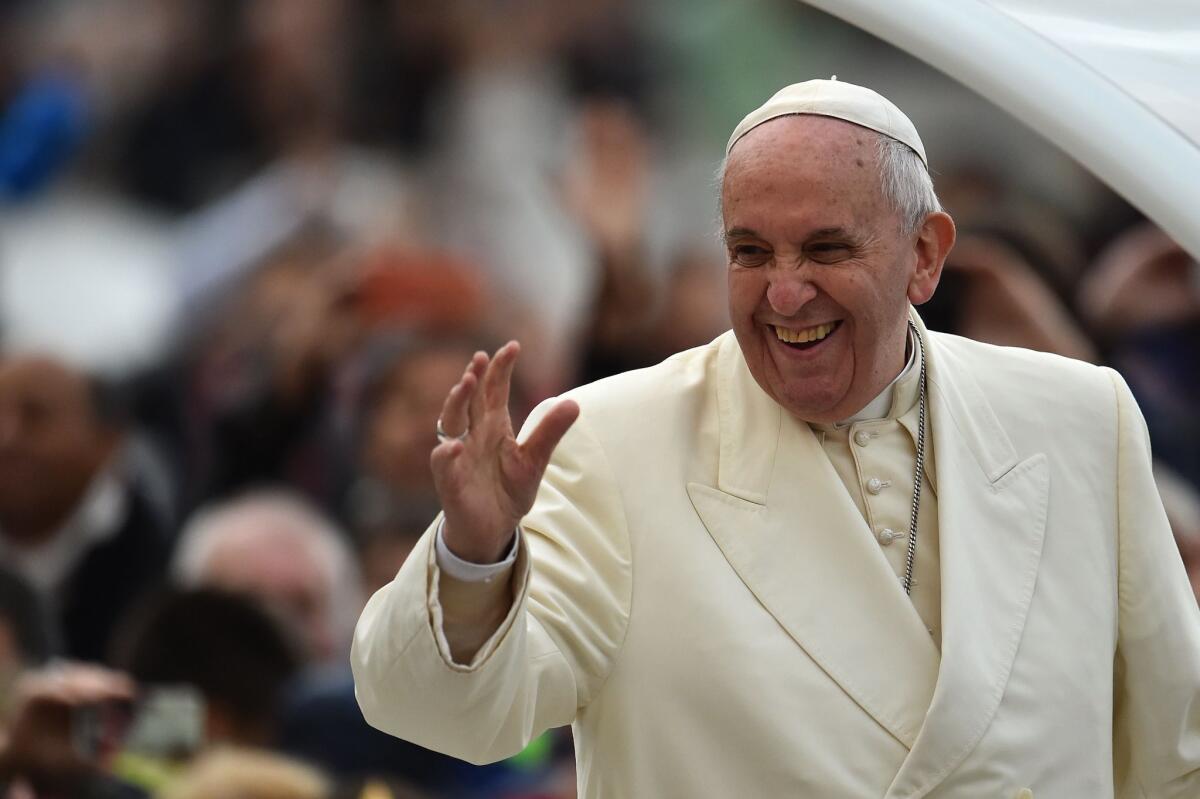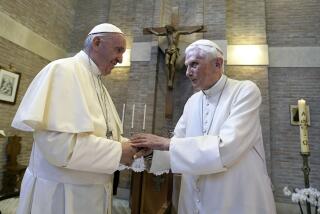Opinion: 10 ways Pope Francis earned our respect in 2014

In 2014, Pope Francis continued to exercise a fascination for members of his Catholic flock and for the rest of the world. There was no papal pronouncement in 2014 to match his electric answer last year to a question about gay priests: “Who am I to judge?” But the Jesuit pope from Argentina continued to press for a more transparent and engaged Catholicism.
But not all of what Francis said and did pleased the liberal Catholics who are his greatest champions. The pope, who is loath to judge gays, did not alter church teachings about homosexuality and the “complementarity” of men and women that is at the heart of Catholicism’s teaching that only heterosexual marriage is part of God’s plan. And at year’s end, he pleased church conservatives by installing a tradition-minded African cardinal as the head of the Vatican office responsible for worship.
Following are some high points the pope’s year:
Thinking about the poor
In January, the pope announced the appointment of 19 cardinals, including 10 from Latin America, the Caribbean, Asia and Africa. The emphasis on elevating clergymen from the developing world was in keeping with Francis’ emphasis on Catholicism as a church for the poor.
Getting the finances in order
Responding to financial scandals that may have figured in Pope Benedict XVI’s decision to retire, Pope Francis in February established a single office to handle all business, administrative and personnel management at the Vatican. The new secretariat for the economy is headed by Cardinal George Pell of Australia. (Later in the year, Pell revealed that his staff discovered hundreds of millions of euros “tucked away” in various Vatican accounts.)
Removing the ‘bishop of bling’
In March, Francis removed Franz-Peter Tebartz-van Elst as the bishop of Limburg, Germany. The cleric, known as the “bishop of bling,” spent $43 million on his official residence in Limburg. Renovations included a $20,000 bathtub, $620,000 in artwork and $1.1 million for landscaping.
Appealing to both factions in the church
In an unprecedented ceremony in April, Francis presided over the canonization of two of his predecessors -- John XXIII and John Paul II. The simultaneous elevation to sainthood of John, a pope revered by liberals, and John Paul II, a hero to many Catholic conservatives, was widely viewed as a statesmanlike attempt to reach out to both factions in the church.
Hosting a prayer meeting for Peres and Abbas
In a spiritual summit meeting that grew out of his trip to the Holy Land, Francis hosted a prayer meeting in June at the Vatican for Presidents Shimon Peres of Israel and Mahmoud Abbas of the Palestinian Authority. The service, which also included Patriarch Bartholomew, the spiritual head of Eastern Orthodox Christians, followed the collapse of U.S.-sponsored peace talks between Israel and the Palestinians.
Meeting with victims of clerical sexual abuse
In July, in what some critics saw as a case of “better late than never,” Francis met for the first time with victims of clerical sexual abuse. The pope compared the abuse to a “sacrilegious cult” that drove its victims to drug addiction and suicide and told six victims from Britain, Ireland and Germany that the church should “weep” and “make reparation” for their suffering.
Appointing a moderate as the new archbishop of Chicago
In what liberals and conservative Catholics alike viewed as a sea change, the pope in September appointed moderate Bishop Blase Cupich of Spokane, Wash., as the new archbishop of Chicago, replacing the retiring Cardinal Francis George. George, an intellectual leader of conservative Catholics, would later attract attention with this comment about the pope: “He says wonderful things, but he doesn’t put them together all the time, so you’re left at times puzzling over what his intention is.”
Presiding over a synod of bishops focused on family
In October, the pope presided over a synod of bishops devoted to issues relating to the family. The meeting produced a preliminary document that said gays and lesbians had “gifts and qualities” that the church should embrace. But even a watered-down version of that statement failed to win the support of two-thirds of the bishops. The same fate befell a proposal -- widely believed to be supported by Francis -- that the church study allowing divorced and remarried Catholics to receive Holy Communion. Francis insisted the vote tally be made public.
Appealing and dismaying both liberal and conservative Catholics
In November, Francis made two more personnel moves. Cardinal Raymond Burke, the former archbishop of St. Louis, was removed from his position as head of the Vatican’s Supreme Court and assigned to the largely honorific position of patron of the Order of the Knights of Malta. The demotion of Burke, who is best known for his opposition to allowing pro-choice Catholic politicians to receive Communion, cheered liberal Catholics and dismayed conservatives. But then Francis appointed a conservative, Cardinal Robert Sarah of Guinea, to head the Congregation for Divine Worship, which regulates the church’s liturgy. That appointment pleased conservatives -- especially those who prefer the traditional Latin Mass -- but was concerning for liberals.
Displaying a dramatic gesture of humility
As the year neared its end, Francis traveled to Turkey, where he again met Patriarch Bartholomew. In a dramatic gesture of humility, the pope asked the Orthodox leader’s blessing “for me and the Church of Rome.” Francis also suggested that if the Catholic and Orthodox churches reunited, Rome would not insist on the “submission of one to the other, or assimilation.”
Follow Michael McGough on Twitter @MichaelMcGough3
MORE YEAR IN REVIEW:
Top 10 feminist fiascoes of 2014
The biggest privacy outrages in 2014
Ted Rall’s 10 most popular cartoons in 2014
Good riddance! What Patt Morrison won’t miss from 2014
This year’s most poignant condemnations of the death penalty
Four ways the 405 freeway project has not made your life better
What’s the best approach to weight loss? Ten 2014 studies to note
2014 was a banner year for politicians behaving badly: 6 rich examples
More to Read
A cure for the common opinion
Get thought-provoking perspectives with our weekly newsletter.
You may occasionally receive promotional content from the Los Angeles Times.







